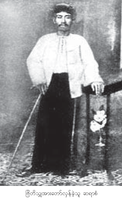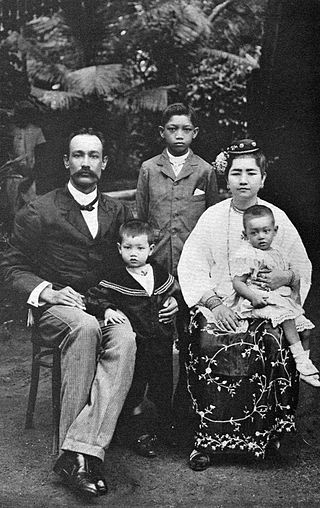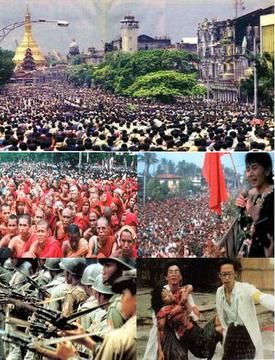
Saya San also spelled Hsaya was a physician, former monk and the leader of the Saya San Rebellion of 1930–1932 in British Burma. The series of uprisings that have been called the Saya San Rebellion has been regarded as one of Southeast Asia's quintessential anti-colonial movements. Because of its national and historical nature, discussions about Saya San and the rebellion associated with him has persisted to this day, particularly within academic spheres.

The Anglo-Burmese people, also known as the Anglo-Burmans, are a community of Eurasians of Burmese and European descent, who emerged as a distinct community through mixed relationships between the British and other Europeans and Burmese people from 1826 until 1948 when Myanmar gained its independence from the British Empire. Those who could not adjust to the new way of life after independence and the ushering in of military dictatorship are dispersed throughout the world. How many stayed in Myanmar is not accurately known.

Burmese Indians are a group of people of Indian origin who live in Myanmar (Burma). The term 'Burmese Indian' refers to a broad range of people from South Asia, most notably from present-day countries such as India and Bangladesh. While Indians have lived in Burma for many centuries, most of the ancestors of the current Burmese Indian community emigrated to Burma from the start of British rule in the mid-19th century to the separation of British Burma from British India in 1937. During colonial times, ethnic Indians formed the backbone of the government and economy serving as soldiers, civil servants, merchants, moneylenders, mobile laborers and dock workers. A series of anti-Indian riots in the 1930s and mass emigration at the onset of the Japanese invasion of Burma in 1942 were followed in the 1960s by the forced migration of hundreds of thousands of ethnic Indians, exacerbated by internal conflict in Myanmar.
A prison riot is an act of concerted defiance or disorder by a group of prisoners against the prison administrators, prison officers, or other groups of prisoners.

British rule in Burma lasted from 1824 to 1948, from the successive three Anglo-Burmese wars through the creation of Burma as a province of British India to the establishment of an independently administered colony, and finally independence. The region under British control was known as British Burma, and officially known as Burma from 1886. Various portions of Burmese territories, including Arakan and Tenasserim, were annexed by the British after their victory in the First Anglo-Burmese War; Lower Burma was annexed in 1852 after the Second Anglo-Burmese War. The annexed territories were designated the minor province of British Burma in 1862.

The 8888 Uprising, also known as the People Power Uprising and the 1988 Uprising, was a series of nationwide protests, marches, and riots in Burma that peaked in August 1988. Key events occurred on 8 August 1988 and therefore it is commonly known as the "8888 Uprising". The protests began as a student movement and were organised largely by university students at the Rangoon Arts and Sciences University and the Rangoon Institute of Technology (RIT).
There is a history of persecution of Muslims in Myanmar that continues to the present day. Myanmar is a Buddhist majority country, with significant Christian and Muslim minorities. While Muslims served in the government of Prime Minister U Nu (1948–63), the situation changed with the 1962 Burmese coup d'état. While a few continued to serve, most Christians and Muslims were excluded from positions in the government and army. In 1982, the government introduced regulations that denied citizenship to anyone who could not prove Burmese ancestry from before 1823. This disenfranchised many Muslims in Myanmar, even though they had lived in Myanmar for several generations.

Insein Prison is located in Yangon Division, near Yangon (Rangoon), the old capital of Myanmar. From 1988 to 2011 it was run by the military junta of Myanmar, named the State Law and Order Restoration Council from 1988 to 2003 and the State Peace and Development Council (SPDC) from 2003 to 2011, and was used largely to repress political dissidents.
A series of workplace disturbances, strikes, and riots broke out across the British West Indies in the period between 1934 and 1939. These began as the Great Depression wore on and ceased on the eve of World War II. The unrest served to highlight inequalities of wealth, led the British government to attempt a solution to the problem, and in some cases spurred the development of indigenous party politics that would lead to self-government and independence in the postwar period.

Dobama Asiayone, commonly known as the Thakhins, was a Burmese nationalist group formed around the 1930s and composed of young, disgruntled intellectuals. Drawing their name from the way in which the British were addressed during colonial times, the party was established by Ba Thaung in May 1930, bringing together traditionalist Buddhist nationalist elements and fresh political ideals. It was significant in stirring up political consciousness in Burma, and drew most of its support base from students.
A prison riot occurred at the CERESO state prison in Ciudad Juárez, Chihuahua, Mexico, on March 4, 2009. During the riots, at least 20 people were killed and 15 were injured. Although a police spokesman stated that no police or jail guards were killed during the riots, the Red Cross said that two policemen had been killed. The riot was a fight among several rival gangs, the "Barrio Azteca", "Los Mexicles" and "Artistas Asesinos" (AA).
The 2013 Myanmar anti-Muslim riots were a series of conflicts in various cities throughout central and eastern Myanmar (Burma).

On 10 February 2016, a prison riot broke out at the Topo Chico prison near Monterrey, in northern Mexico. 49 inmates were killed during the riot and ensuing fire. The riot was the most deadly in Mexican penal history, surpassing the death toll of the 2012 Apodaca prison riot. After the rioting, authorities uncovered 'luxury cells' prison leaders had. Among the items confiscated included televisions, mini-fridges, aquariums, and saunas.

Captain Richard Boswell Rushall was a British sea captain and businessman who served as mayor of Rangoon, Burma, during the 1930s. He was the first Englishman to hold this position. Born in Braunston, Northamptonshire, Rushall was the eldest of eight children. After finishing school he left for sea, joined the UK's Merchant Navy, and became a ship's captain. He spent 20 years with the Irrawaddy Flotilla Company, of which 17 were in command of steamships belonging to the company. In 1908 he settled in Rangoon with his family, resigned from the Irrawaddy Flotilla Company and founded Rushall & Co. Ltd., a stevedoring and contracting business that employed between 3,000 and 4,000 men.
Rangoon riots may refer to:

Two prison riots occurred at the Cieneguillas Regional Center for Social Reintegration in Cieneguillas, Zacatecas, Mexico. The first was on 31 December 2019, and the second on 2 January 2020. Sixteen inmates were killed on 31 December, and another inmate was killed on 2 January.
Mahara prison riot was an arson attack which took place between the prison inmates and police officials from 29 November 2020 to 30 November 2020 at the Mahara Prison in Sri Lanka at the outskirts of the capital city of Colombo in Mahara. As of 30 November 2020, 11 inmates were reportedly killed and about 117 inmates were severely injured during the prison riot. Police guards opened fire to control the arson attack and also in order to prevent a jail break. A fire also spread from the Mahara fire following gun shots, and most of the deceased inmates succumbed to gun shots. It was revealed that prison inmates set fire to the kitchens inside the prison facility and briefly took 2 wardens hostage. The riots occurred following the rumours and speculations regarding the transferring of COVID-19 infected prisoners to Mahara Prison from other crowded prisons. Initially the prison inmates staged unrest demanding the officials and authorities to increase the PCR testing following the surge in COVID-19 cases in Sri Lankan prisons. Prior to the riots, around 12 prisoners tested positive for COVID-19.
On 23 February 2021, 79 inmates were killed and several others were injured in riots that took place simultaneously in four prisons in Ecuador. Authorities gave gang rivalry in an overcrowded prison system as the cause. The violence happened in prisons located in the Guayas, Azuay, and Cotopaxi provinces, which contain nearly 70% of the total prison population in the country.
The September 2021 Guayaquil prison riot occurred at the Litoral Penitentiary in Guayaquil, Ecuador on 28 September 2021. At least 123 inmates were killed and several others were injured in the riot that took place in that prison. It was the deadliest prison fight in the country's history and one of the deadliest in Latin American history.










